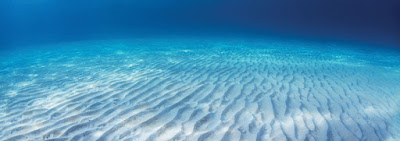And it came to pass after seven days, that the waters of the flood were upon the earth.
Genesis 7:10"Most agree that the Flood/post-Flood boundary is at one of two levels:
1) at the top of the Cretaceous system, known as the K-Pg (K-T) horizon, or
2) at or near the top of the Neogene (Upper Cenozoic) at about the Pliocene level.
....five major geological observations that demonstrate the Flood/post-Flood boundary is much higher than the K-Pg level. Some of these features are so large and/or unusual in scale that local post-Flood catastrophes could not have conceivably produced them....Collectively, they strongly refute the claim that the Flood ended at the stratigraphic level of the K-Pg boundary:
 |
| Whopper Sand |
2. The tremendous amount of Tejas sediment deposited globally. The volume of Tejas sediment is second only to the Zuni megasequence that ended with the Cretaceous system, the presumed high-water point of the Flood. The tremendous amount of Paleogene and Neogene sediments all over the world that are part of the Tejas megasequence cannot be easily dismissed as the product of local
catastrophes. These sediments, and the fossils they contain, are better explained by the receding water phase of the Flood as mountain ranges and plateaus were being uplifted.
3. The thickest and most extensive coal seams are found globally in Tejas sediments. The Powder River Basin (PRB) coals, which are all within Paleogene system rock layers, contain the largest reserves of low-sulfur subbituminous coal in the world. At least six or more coal beds in the PRB exceed 100 feet in thickness and some individual beds have been shown to extend for over 75 miles. Some of these coal beds can exceed 200 feet thick in places, such as the Big George coal layer. These coal beds are part of the receding phase of the Flood that transported huge mats of plant and tree debris. They were derived largely from angiosperms living at higher elevations, and then Flood waters rapidly buried them in huge deposits.
4. The tremendous amount of rapid ocean crust/seafloor spreading that continued right across the K-Pg boundary and up to the Pliocene, with no indication of a significant change in velocity. The runaway subduction model for the global flood, described by Geophysicist Dr. John Baumgardner, caused the creation of approximately one-third to one-half of the world’s ocean crust to form during the deposition of the Tejas megasequence (Paleocene through Pliocene). In addition, the huge earthquakes generated by this movement would have been devastating for any type of human civilization after the Flood, if the Flood/post-Flood boundary is located at the K-Pg.
5. The identification of uninterrupted water-deposited carbonate rocks from the Cretaceous (below the K-Pg boundary) and continuing upward through Miocene strata across much of North Africa and the Middle East, areas just to the south of the landing site for the ark in Turkey. The continuous limestone beds from the time of Cretaceous deposition (Zuni megasequence) through the top of the Miocene (Upper Tejas) in Iraq are the closest thing to proof that the Flood was not over at this point. These huge regions of the Middle East were clearly still under water during the Tejas. If they were post-Flood deposits, it would be impossible for humans to settle there at that time and build the Tower of Babel.
In addition, our research efforts have identified more geological features that further support that the Flood/post-Flood boundary is near the top of the Tejas megasequence which encompasses the Paleogene and Neogene geological systems. Local post-Flood catastrophes cannot explain this continuous sand bed that covers much of the Great Plains. It must be part of the receding phase of the Flood as well.
Collectively, these data establish that much of the Paleogene and Neogene (known previously as the Tertiary) was the receding phase of the great Flood, placing the Flood/post-Flood boundary at the top of the Tejas megasequence (Upper Cenozoic). Real rock data not only confirm there was a global Flood as described in the Bible, but they also help us to better understand its final stages of sedimentary deposition." ICR

